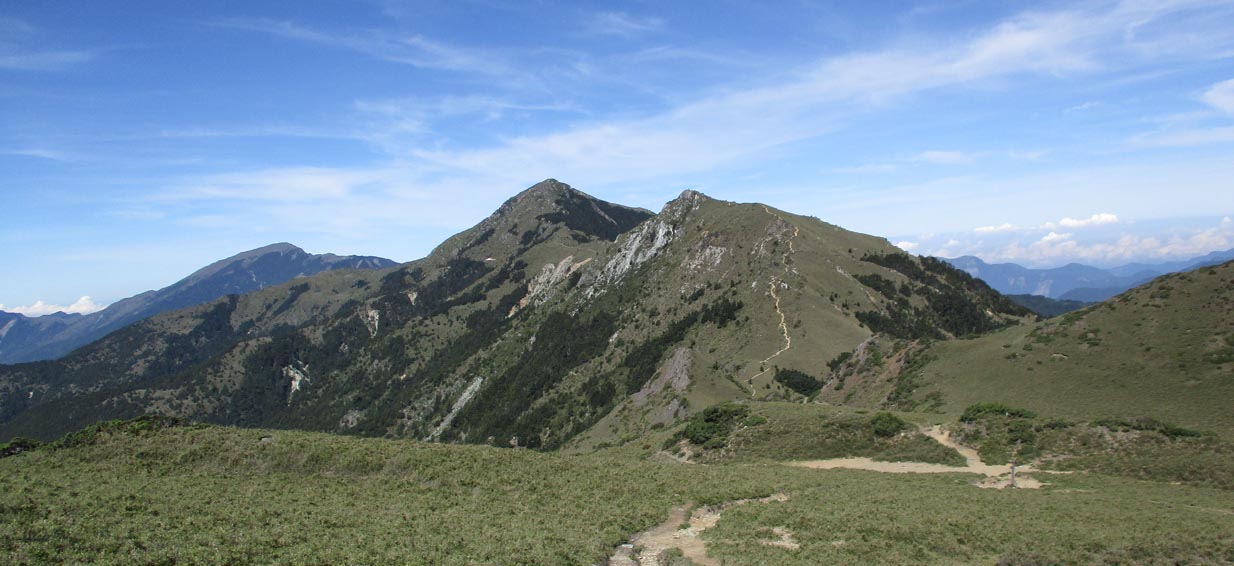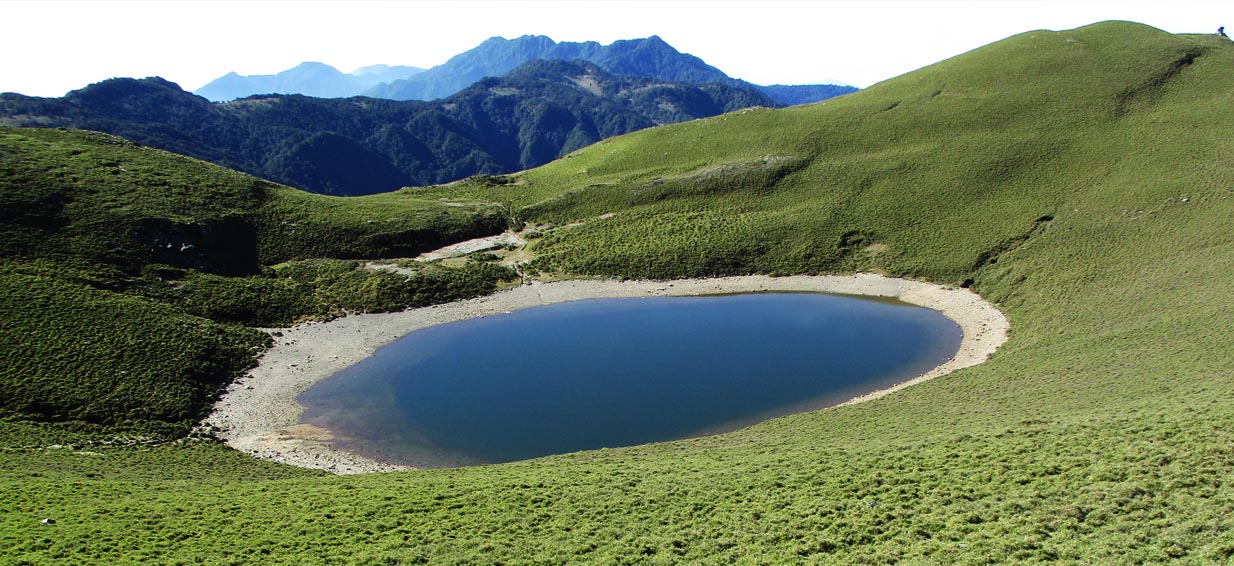Jiaming Lake National Trail
Jiaming Lake Trail

A part of the second section of the Central Mountain Range, the Jiaming Lake National Trail crosses Taiwan""s hemlock forest, fir forest, bare rocks, cliffs, Yushan Cane grassland and mountain ridges. The ridge trail offers a vast view, with the sea of clouds and clusters of mountains below, giving people a sense of walking atop the world. Landscapes such as magnificent alpines, deep valleys, broken cliffs, ever-changing clouds, emerald mosaic of luscious forests and grasslands, rare calls of the deer, continuous peaks, winter snow scene, bright moonlight and starry nights have always attracted climbers. However, the trail is long, with sharp inclines and sudden drops that clearly challenge the physical strength and stamina of climbers. The alpine ecological is rich and diverse. With rising altitude, mixed coniferous-broad-leave forest gradually gives way to intertwining growths of Taiwan Hemlock and fir. Even higher up, the view becomes a beautiful weave of forest and grassland. The changing ecological environment forms a perfect habitat for birds, amphibians and mammals such as the Formosan giant flying squirrel, Formosan yellow-throated marten, Formosan barking deer and Formosan sambar deer. In particular, the gentle valley of the alpine forest and grassland around Jiaming Lake are home to the Sambar deer. In recent years, friendly climbers have closed the distance between deer and humans; but please remember, do not feed the deer to avoid changing their living habits.
The trail cuts through Siangyang Mountain and Sancha Mountain, which offer unique ecological landscape. Siangyang Mountain is the southernmost boundary of tundra ecological in the Central Mountain Range while Sancha Mountain is famous for its vast and magnificent alpine grassland and the beautiful Jiaming Lake, which lays nestled like a splendid sapphire. The gorgeous flowers in full bloom during spring and summer as well as winter snow scene of the two mountains bring great cheer to climbers on the rugged and long mountain road. Slow down here, enjoy the flowers, and pace your breathing and strength for the longer trail ahead.
Single-seed Juniper Symbol of tenacity

Also known as Xiangqing, the single-seed Juniper is the oldest tree species in Taiwan. Mostly distributed in the alpine tundra more than 3,400 meters above sea level, it is a major member of the dwarf shrub that grows above timberline, and is extremely important to soil and water conservation. The evergreen single-seed Juniper is supposed to be towering and straight. When striving to adapt to a harsh natural environment, despite sheared by cutting wind and bent by heavy snow, it clings to the meager soil of high mountain and grows upward for survival. Hence we can often see tough, strong single-seed Junipers in varying postures on mountain peaks. However, single-seed Junipers found in leeward or valley terrain are straight and tall.
Siangyang Mountain Landslide Jagged and imposing
.jpg)
Rising 3,603 meters above sea level, Siangyang Mountain is the second highest peak in Taitung County. It is also Taiwan""s final base for the southward distribution of Eurasia cold zone plants. Climbing on the mountain trail to the peak, the experience of seeing white clouds slowly drifting toward the ridge trails then being shrouded in them is awe-inspiring.
The most striking topographical landscape here is the landslide in the southwestern slope of Siangyang Mountain. The wall has collapsed all the way from the top of the cliff to Yakou Village on the Southern Cross-Island Highway, creating a drop of 800 meters. The trail through the imposing barren wall and broken boulders are piled with rocks and stones, and hikers must be particularly cautious. Since the exposed wall is a metamorphic rock layer, it appears brightly colored in the sun, but at dusk, it turns red from the reflecting rays of the setting sun. From a distance, the mountain seems red with maple, and hence it is also called Red Leaf Mountain.
Sancha Mountain Magnificent and vast alpine grassland

The Sancha Mountain is situated at the intersection of the main ridge of the Central Mountain Range and the branch of Bulakesang Mountain. Also known as Xiayunsha Mountain, it has an elevation of 3,496 meters and is one of the top ten mountains in Taiwan. The highest point of the Sancha Mountain is a rise of Yushan Cane grassland. Covered with undulating waves of gentle slopes, this vast grassland has become known as the Pamir of Taiwan in the mountaineering industry. This rare alpine prairie in Taiwan is also a paradise for large grass-eating Formosan Sambar Deer, and sightings of the deer community have been quite common in recent years. The peak of Sancha Mountain is a first order triangulation station. With its unrestricted view and low hanging clouds, the panorama is excellent. In addition to the distant Xiuguluan Mountan, Xinkang Mountain, Yunfeng, Siangyang Mountain and the Yushan Mountain Peaks, the forest boundary comprises the advance and retreat of the Yushan Cane grassland and fir forest over the years, and changes with the light and environment.
At this stage, the fir colony is expanding its territory with seeds and seedlings, and these young trailblazers can be clearly seen pushing bravely through the edges of the forest. However, in the event of a natural disaster such as wildfire burning down the forest, the Yushan Cane will once again regain the survival plate. Such is the story of nature, constantly being rewritten as the environmental changes.
Jiaming Lake Sapphire on green velvet

Jiaming Lake is a mountain lake located about 3,310 meters above sea level on the southeastern of Sancha Mountain, and second only to the Cui Pond in Hsuehshan. It is also called the Egg Pond because of its almost elliptical outline while climbers also call it Angel""s Tears because of its clear blue water. According to the Central Geological Survey, Ministry of Economic Affairs, debris along in the banks of Jiaming Lake contain glassy materials from high-temperature explosions, which puts the formation of the Jiaming Lake to tens of thousands of years ago from the meteorite impact. However, another theory believes that the lake was formed by glacial erosion since the lake has no water source from mountains streams or creeks, yet stays full all year round.
On sunny days, the lake sparkles like a sapphire rested against the lush Yushan Cane grassland. After a long and arduous journey, when climbers arrive at the lake, all fatigue transforms into sighs of praise. Sitting next to the quiet lake and blue sky, away from the burdens of the world, only those who have been here to gaze at the vast expanse of heaven and absorb the waters and clouds could fathom the gift of nature exchanged from every drop of sweat and labored breath.
